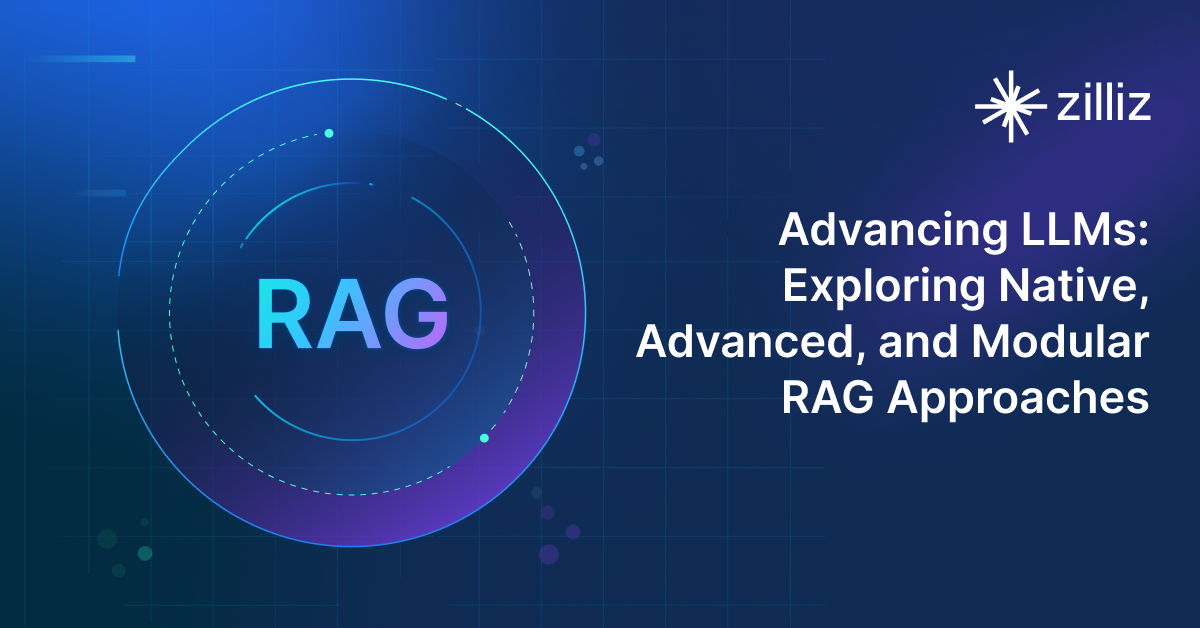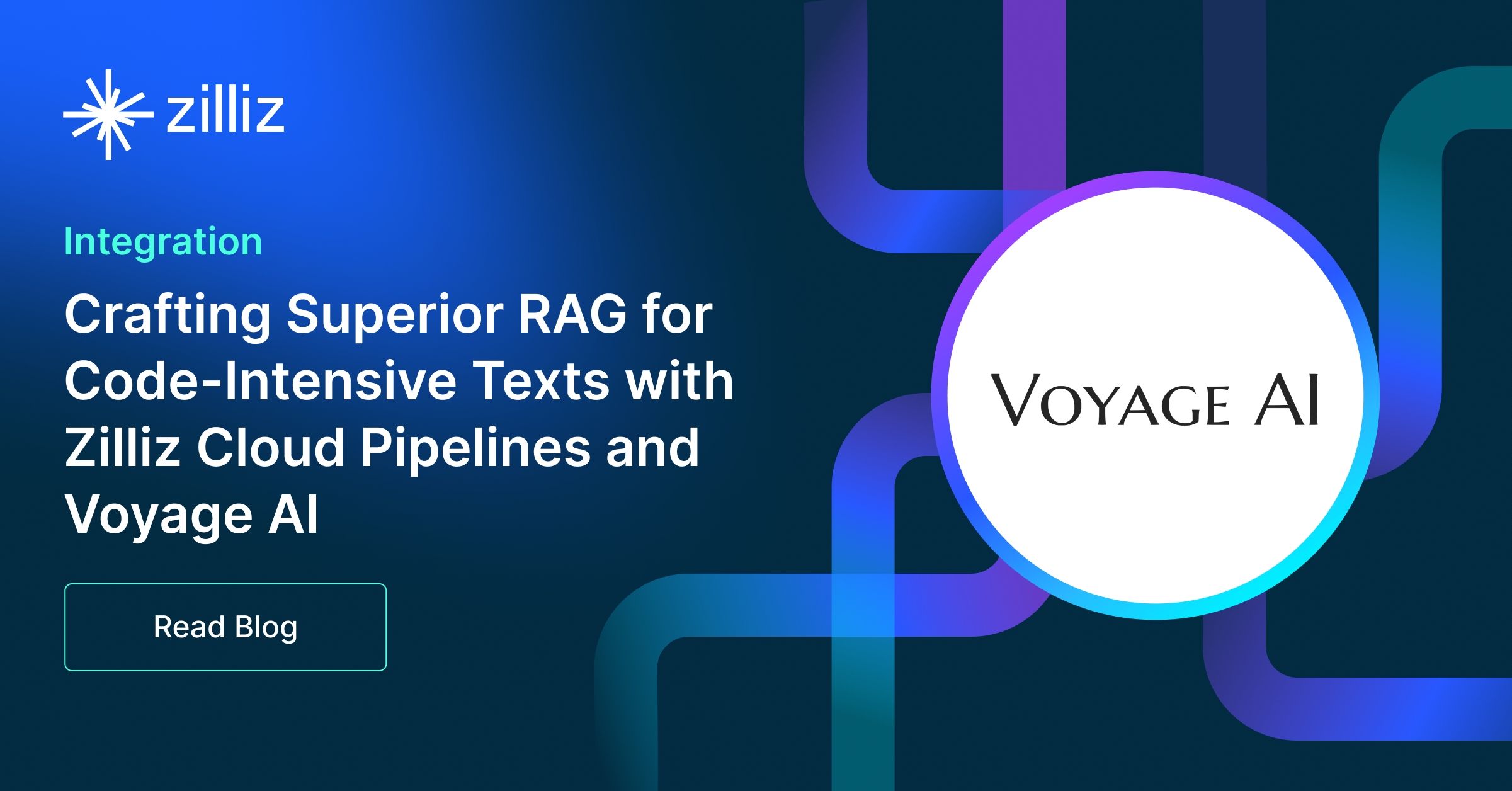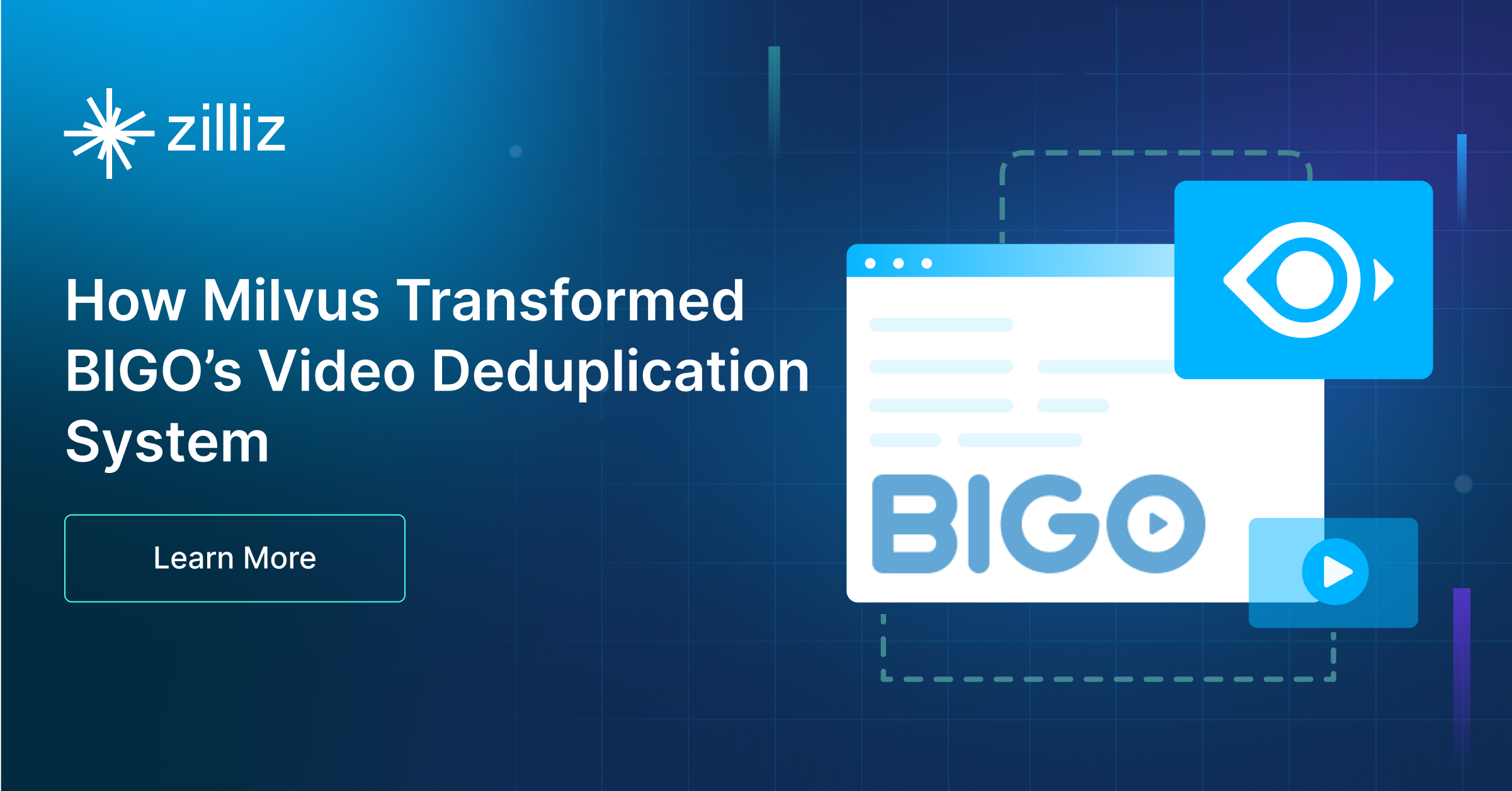Build RAG Chatbot with LangChain, Milvus, AWS Bedrock Claude 3 Haiku, and IBM all-minilm-l12-v2
Introduction to RAG
Retrieval-Augmented Generation (RAG) is a game-changer for GenAI applications, especially in conversational AI. It combines the power of pre-trained large language models (LLMs) like OpenAI’s GPT with external knowledge sources stored in vector databases such as Milvus and Zilliz Cloud, allowing for more accurate, contextually relevant, and up-to-date response generation. A RAG pipeline usually consists of four basic components: a vector database, an embedding model, an LLM, and a framework.
Key Components We'll Use for This RAG Chatbot
This tutorial shows you how to build a simple RAG chatbot in Python using the following components:
- LangChain: An open-source framework that helps you orchestrate the interaction between LLMs, vector stores, embedding models, etc, making it easier to integrate a RAG pipeline.
- Milvus: An open-source vector database optimized to store, index, and search large-scale vector embeddings efficiently, perfect for use cases like RAG, semantic search, and recommender systems. If you hate to manage your own infrastructure, we recommend using Zilliz Cloud, which is a fully managed vector database service built on Milvus and offers a free tier supporting up to 1 million vectors.
- AWS Bedrock Claude 3 Haiku: This model harnesses the power of Claude 3 within AWS's Bedrock service, facilitating scalable AI solutions. It excels in natural language understanding and generation tasks, making it ideal for customer support, content creation, and conversational agents. Its integration with cloud infrastructure ensures flexibility and ease of deployment for enterprises.
- IBM all-minilm-l12-v2: This model is a compact yet powerful transformer-based architecture optimized for natural language understanding and processing tasks. It excels in scenarios requiring efficient computation without sacrificing performance, making it ideal for applications in chatbots, information retrieval, and sentiment analysis. Its lightweight design enables integration in resource-constrained environments while maintaining competitive accuracy.
By the end of this tutorial, you’ll have a functional chatbot capable of answering questions based on a custom knowledge base.
Note: Since we may use proprietary models in our tutorials, make sure you have the required API key beforehand.
Step 1: Install and Set Up LangChain
%pip install --quiet --upgrade langchain-text-splitters langchain-community langgraph
Step 2: Install and Set Up AWS Bedrock Claude 3 Haiku
pip install -qU "langchain[aws]"
# Ensure your AWS credentials are configured
from langchain.chat_models import init_chat_model
llm = init_chat_model("anthropic.claude-3-haiku-20240307-v1:0", model_provider="bedrock_converse")
Step 3: Install and Set Up IBM all-minilm-l12-v2
pip install -qU langchain-ibm
import getpass
import os
if not os.environ.get("WATSONX_APIKEY"):
os.environ["WATSONX_APIKEY"] = getpass.getpass("Enter API key for IBM watsonx: ")
from langchain_ibm import WatsonxEmbeddings
embeddings = WatsonxEmbeddings(
model_id="sentence-transformers/all-minilm-l12-v2",
url="https://us-south.ml.cloud.ibm.com",
project_id="<WATSONX PROJECT_ID>",
)
Step 4: Install and Set Up Milvus
pip install -qU langchain-milvus
from langchain_milvus import Milvus
vector_store = Milvus(embedding_function=embeddings)
Step 5: Build a RAG Chatbot
Now that you’ve set up all components, let’s start to build a simple chatbot. We’ll use the Milvus introduction doc as a private knowledge base. You can replace it with your own dataset to customize your RAG chatbot.
import bs4
from langchain import hub
from langchain_community.document_loaders import WebBaseLoader
from langchain_core.documents import Document
from langchain_text_splitters import RecursiveCharacterTextSplitter
from langgraph.graph import START, StateGraph
from typing_extensions import List, TypedDict
# Load and chunk contents of the blog
loader = WebBaseLoader(
web_paths=("https://milvus.io/docs/overview.md",),
bs_kwargs=dict(
parse_only=bs4.SoupStrainer(
class_=("doc-style doc-post-content")
)
),
)
docs = loader.load()
text_splitter = RecursiveCharacterTextSplitter(chunk_size=1000, chunk_overlap=200)
all_splits = text_splitter.split_documents(docs)
# Index chunks
_ = vector_store.add_documents(documents=all_splits)
# Define prompt for question-answering
prompt = hub.pull("rlm/rag-prompt")
# Define state for application
class State(TypedDict):
question: str
context: List[Document]
answer: str
# Define application steps
def retrieve(state: State):
retrieved_docs = vector_store.similarity_search(state["question"])
return {"context": retrieved_docs}
def generate(state: State):
docs_content = "\n\n".join(doc.page_content for doc in state["context"])
messages = prompt.invoke({"question": state["question"], "context": docs_content})
response = llm.invoke(messages)
return {"answer": response.content}
# Compile application and test
graph_builder = StateGraph(State).add_sequence([retrieve, generate])
graph_builder.add_edge(START, "retrieve")
graph = graph_builder.compile()
Test the Chatbot
Yeah! You've built your own chatbot. Let's ask the chatbot a question.
response = graph.invoke({"question": "What data types does Milvus support?"})
print(response["answer"])
Example Output
Milvus supports various data types including sparse vectors, binary vectors, JSON, and arrays. Additionally, it handles common numerical and character types, making it versatile for different data modeling needs. This allows users to manage unstructured or multi-modal data efficiently.
Optimization Tips
As you build your RAG system, optimization is key to ensuring peak performance and efficiency. While setting up the components is an essential first step, fine-tuning each one will help you create a solution that works even better and scales seamlessly. In this section, we’ll share some practical tips for optimizing all these components, giving you the edge to build smarter, faster, and more responsive RAG applications.
LangChain optimization tips
To optimize LangChain, focus on minimizing redundant operations in your workflow by structuring your chains and agents efficiently. Use caching to avoid repeated computations, speeding up your system, and experiment with modular design to ensure that components like models or databases can be easily swapped out. This will provide both flexibility and efficiency, allowing you to quickly scale your system without unnecessary delays or complications.
Milvus optimization tips
Milvus serves as a highly efficient vector database, critical for retrieval tasks in a RAG system. To optimize its performance, ensure that indexes are properly built to balance speed and accuracy; consider utilizing HNSW (Hierarchical Navigable Small World) for efficient nearest neighbor search where response time is crucial. Partitioning data based on usage patterns can enhance query performance and reduce load times, enabling better scalability. Regularly monitor and adjust cache settings based on query frequency to avoid latency during data retrieval. Employ batch processing for vector insertions, which can minimize database lock contention and enhance overall throughput. Additionally, fine-tune the model parameters by experimenting with the dimensionality of the vectors; higher dimensions can improve retrieval accuracy but may increase search time, necessitating a balance tailored to your specific use case and hardware infrastructure.
AWS Bedrock Claude 3 Haiku optimization tips
Claude 3 Haiku on AWS Bedrock is designed for speed and efficiency, making it ideal for real-time RAG applications. Optimize retrieval by prioritizing high-precision embeddings and filtering out low-relevance documents before passing them to the model. Keep prompts structured with clear formatting to help the model focus on the most critical context. Use temperature settings between 0.1 and 0.3 for factual accuracy and adjust top-p to balance diversity. For latency-sensitive applications, leverage AWS Bedrock’s scaling capabilities to ensure smooth performance under heavy loads. Implement caching for frequently accessed queries to reduce API calls and improve response times. If used in a multi-model setup, reserve Haiku for fast preliminary filtering or summarization before escalating complex queries to larger models.
IBM all-minilm-l12-v2 optimization tips
To optimize the IBM all-minilm-l12-v2 model in a Retrieval-Augmented Generation (RAG) setup, consider fine-tuning it on domain-specific datasets to enhance relevance and accuracy for your particular use case. Implement model distillation techniques to reduce inference time while maintaining performance. Additionally, ensure efficient batch processing by adjusting the maximum sequence length based on your input data, and utilize mixed precision training to improve computational efficiency. Regularly evaluate the model's performance with various retrieval methods to identify the best combination and consider employing caching strategies for frequently accessed data to minimize latency. Finally, experiment with different hyperparameters, like learning rate and dropout rates, during fine-tuning to achieve optimal results.
By implementing these tips across your components, you'll be able to enhance the performance and functionality of your RAG system, ensuring it’s optimized for both speed and accuracy. Keep testing, iterating, and refining your setup to stay ahead in the ever-evolving world of AI development.
RAG Cost Calculator: A Free Tool to Calculate Your Cost in Seconds
Estimating the cost of a Retrieval-Augmented Generation (RAG) pipeline involves analyzing expenses across vector storage, compute resources, and API usage. Key cost drivers include vector database queries, embedding generation, and LLM inference.
RAG Cost Calculator is a free tool that quickly estimates the cost of building a RAG pipeline, including chunking, embedding, vector storage/search, and LLM generation. It also helps you identify cost-saving opportunities and achieve up to 10x cost reduction on vector databases with the serverless option.
 Calculate your RAG cost
Calculate your RAG cost
What Have You Learned?
By diving into this tutorial, you’ve unlocked the power of building a modern RAG system from the ground up! You learned how LangChain acts as the glue, seamlessly orchestrating workflows between components, while Milvus—the lightning-fast vector database—stores and retrieves embeddings with precision. The IBM all-minilm-l12-v2 model transformed your raw text into rich numerical representations, making semantic search possible, and AWS Bedrock’s Claude 3 Haiku brought human-like fluency to generated responses, balancing speed and accuracy. Together, these tools form a dynamic pipeline: ingest data, embed it, store it for retrieval, and enhance LLM outputs with context-aware answers. You also picked up pro tips for optimizing performance, like tuning chunk sizes for embeddings and balancing cost-efficiency with quality—plus, you now have access to a free RAG cost calculator to budget your projects smartly. Every step you’ve taken demystifies how enterprise-grade AI systems work, putting you in control of scalable, intelligent applications!
But this isn’t just about following steps—it’s about empowerment. You’ve seen firsthand how combining frameworks, databases, and models opens doors to chatbots that truly understand context, search engines that grasp intent, and AI assistants that feel almost magical. The synergy between LangChain’s flexibility, Milvus’s scalability, Claude 3’s wit, and IBM’s compact embeddings proves that you’re not just building tools; you’re crafting experiences. Now it’s your turn! Experiment with those optimization tricks, plug in the cost calculator to plan like a pro, and start shaping your own RAG-powered solutions. Whether you’re automating workflows, personalizing user interactions, or tackling entirely new challenges, you’ve got the blueprint. So fire up your IDE, tweak those parameters, and let your creativity run wild—the future of intelligent apps is yours to build. 🚀
Further Resources
🌟 In addition to this RAG tutorial, unleash your full potential with these incredible resources to level up your RAG skills.
- How to Build a Multimodal RAG | Documentation
- How to Enhance the Performance of Your RAG Pipeline
- Graph RAG with Milvus | Documentation
- How to Evaluate RAG Applications - Zilliz Learn
- Generative AI Resource Hub | Zilliz
We'd Love to Hear What You Think!
We’d love to hear your thoughts! 🌟 Leave your questions or comments below or join our vibrant Milvus Discord community to share your experiences, ask questions, or connect with thousands of AI enthusiasts. Your journey matters to us!
If you like this tutorial, show your support by giving our Milvus GitHub repo a star ⭐—it means the world to us and inspires us to keep creating! 💖
- Introduction to RAG
- Key Components We'll Use for This RAG Chatbot
- Step 1: Install and Set Up LangChain
- Step 2: Install and Set Up AWS Bedrock Claude 3 Haiku
- Step 3: Install and Set Up IBM all-minilm-l12-v2
- Step 4: Install and Set Up Milvus
- Step 5: Build a RAG Chatbot
- Optimization Tips
- RAG Cost Calculator: A Free Tool to Calculate Your Cost in Seconds
- What Have You Learned?
- Further Resources
- We'd Love to Hear What You Think!
Content
Vector Database at Scale
Zilliz Cloud is a fully-managed vector database built for scale, perfect for your RAG apps.
Try Zilliz Cloud for Free


